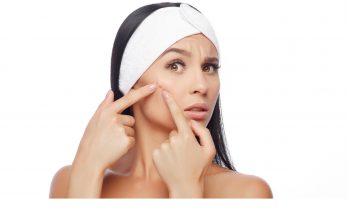Most people are familiar with exfoliation, but the optimal frequency seems to be up for debate.
Before I try to get you on board with exfoliating daily, let’s go over the ways in which exfoliation can benefit the skin.
Your skin cells regenerate every month or so. This means that as you produce new cells, the outer layer begins to die off, at which point you might notice flaking, rough patches, a dull complexion, or discoloration. Since dry, dead skin can clog your pores, it can also lead to blackheads and blemishes. If you never exfoliated, your skin would still shed the upper layer on its own, but exfoliation helps speed up the process.
Exfoliation removes the dead cells on the surface of your face, neck, and décolletage, ultimately revealing new skin underneath. The result is a more even complexion, smoother skin, better hydration, a reduction in fine lines, and fewer blackheads and breakouts. Also, by removing a barrier of dead cells, exfoliation can help your skin absorb the products you use.
The Daily Exfoliation Theory
At some point or another, you’ve probably been told that exfoliating too often can be hard on the skin. But this advice dates back to when people used rough, grating exfoliants that actually scratch and irritate the skin (I’m looking at you, apricot scrub). In today’s beauty world, daily exfoliation is the name of the game.
I used to think once a day was overkill. That is, until I heard Dr. Dennis Gross, a New York City dermatologist and the unofficial King of Skincare, interviewed on a podcast. His stance is that gentle daily exfoliation can produce incredible results without wreaking havoc on your skin.
The analogy Dr. Gross gave is that if you had a special event coming up, you wouldn’t exercise vigorously for one day and then call it quits expecting to be in shape. Obviously, it takes more than a day to get fit, and you also might injure yourself or experience immense soreness. The same goes for exfoliation. If you exfoliate lightly each day, you’ll gradually improve your skin and achieve better results than you would with a single harsh treatment.
Chemical vs. Physical Exfoliation
If I’ve caught your attention, the next thing we need to go over is the different ways you can exfoliate. There are two main types: chemical exfoliation and physical (or mechanical) exfoliation.
With chemical exfoliation, AHAs (alpha-hydroxy acids) are applied to the skin to loosen and dissolve dead cells and oils. The most common AHAs are glycolic acid, salicylic acid, lactic acid, and malic acid. The thing about acids is that they’re not as scary as they sound. AHAs are actually naturally derived from willow bark, cane sugar, fruit, and fermented bacteria. In other words, chemical exfoliation isn’t as “chemically” as it sounds and generally tolerated by most skin types. It’s my preferred method.
Physical exfoliation removes dead skin cells by physically polishing them off, either with a product containing super-fine particles or just a clean washcloth. Technically, apricot scrubs and all other grainy exfoliants fall into this category. But these days, you can find tons of extra-gentle formulas containing things like powdered rice bran to smooth the skin.
If you’re not ready to hop on the daily exfoliation bandwagon just yet, no sweat! Try it a few times a week, and if you like what you see, bump up the frequency. There are no real rules in skin care—only passionate people (like me) who want to share the glory of good skin.



